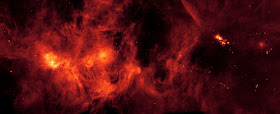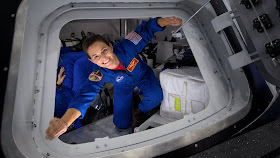Boeing & NASA - Orbital Flight Text (OFT) patch.
Dec 21, 2019
Atlas V launches Starliner
Launched Friday at the international space station by NASA, the Starliner capsule of the manufacturer Boeing encountered a problem in flight.
Boeing suffered a major setback Friday when it failed to send its new Starliner capsule to the International Space Station (ISS), without an astronaut on board. It was to be a dress rehearsal before the sending of NASA crews in 2020. An Atlas V rocket had taken off without problem from Cape Canaveral before dawn, and Starliner, fixed at its top, had detached a quarter of hour after.
Starliner’s orbital insertion maneuver
Video above: Boeing’s CST-100 Starliner crew capsule failed to perform the orbital insertion maneuver approximately 31 minutes after being launched by a United Launch Alliance Atlas V N22 launch vehicle, with a dual engine Centaur upper stage, from Space Launch Complex 41 (SLC-41), Cape Canaveral Air Force Station, Florida, on 20 December 2019, at 11:36:43 UTC (06:36 EST). Video Credits: Boeing/NASA/SciNews.
However, the capsule's engines did not start as expected, and the capsule was therefore unable to get on the right trajectory to catch up with the ISS, which flies in Earth orbit at an altitude of approximately 400 km. Having missed the window and consumed too much fuel while trying to correct the position automatically, Starliner will therefore be brought back prematurely to land within 48 hours in New Mexico, in the western United States, announced a Boeing director. at a press conference at the Kennedy Space Center, three hours after launch.
"Obvious challenges"
This test mission, the first in orbit, was crucial both for the reputation of Boeing, tarnished by the setbacks of its 737 MAX aircraft, and for American national pride. Since 2011, NASA has been dependent on the Russians to send its astronauts into space. American companies Boeing and SpaceX are expected to take over in 2020 with their new capsules.
NASA boss Jim Bridenstine, however, said that despite "obvious challenges", all of this was "very positive in general". The aircraft is in good condition and under control, the experiment will be useful, and no astronaut would have been potentially endangered, he said. He did not rule out that the first manned Starliner mission, initially scheduled for early 2020, could be maintained. "I'm not ruling it out," said the agency official, adding that it was still "too early" to predict if or how the schedule would change.
"We could have started this push manually," said Nicole Mann, one of three astronauts scheduled for the first manned mission, who renewed her confidence in the aircraft. "We can't wait to fly aboard the Starliner."
Unknown initial cause
The anomaly occurred in the on-board “elapsed time” counter in the mission. Having an incorrect schedule, Starliner did not perform the push at the time it was supposed to trigger, shortly after detaching from the rocket. When the Boeing and NASA control rooms tried to correct the problem manually, the capsule could not receive the command directly because it was in transition between two communication satellites.
Starliner anomaly explained
Video above: Boeing’s CST-100 Starliner crew capsule will land at the White Sands Space Harbor, on the White Sands Missile Range, New Mexico, on 22 December 2019, at approximately 12:57 UTC (05:57 MST, 07:57 EST, 04:57 PST). A backup opportunity is schedueled at the same site at 20:48 UTC (13:48 MST). Jim Chilton, senior vice president of Boeing’s Space and Launch Division, explained the anomaly that lead to an off-nominal orbital insertion, putting Starliner in an unplanned orbit. Video Credits: Boeing/NASA/SciNews.
When they regained control, the teams determined that there was not enough fuel left to continue the mission and attempt the docking with the ISS, which was scheduled for Saturday. "We don't yet understand the root cause," said Jim Chilton, vice president of space for Boeing. Under the presidency of Barack Obama, the space agency had contracted billions of dollars with Boeing and SpaceX to develop capsules "made in the USA". After two years of delay, the program finally comes to fruition, but the approval of the vehicles depends on the latest tests.
The SpaceX solution
SpaceX has already passed the stage that Boeing was trying to take with this mission. Elon Musk's company sent its Crew Dragon capsule to the ISS in March and brought it back to Earth without a problem, with a mannequin on board. However, it has yet to complete parachute testing. This is the advantage of having chosen two separate partners, noted Jim Bridenstine. If one vehicle has a problem, the other can continue to serve NASA.
Artist's view of Boeing Starliner in orbit
These programs are distinct from the Artemis project to return to the Moon by 2024, which will be done with a third capsule adapted for deeper journeys in space, Orion, built by Lockheed Martin. At a press conference Thursday, the boss of NASA had declared his confidence in Boeing, stuck in the crisis of its flagship 737 MAX. "The people who develop the spacecraft are different from the people who make the planes," he said.
NASA, Boeing to Provide Update on Starliner Orbital Flight Test Status
The uncrewed Boeing Starliner spacecraft launched on a United Launch Alliance Atlas V rocket at 6:36 a.m. Friday, from Space Launch Complex 41 at Cape Canaveral Air Force Station in Florida on a flight test to the International Space Station. The Starliner did not reach the planned orbit and will not dock to the space station. Teams worked quickly to ensure the spacecraft was in a stable orbit and preserved enough fuel for a landing opportunity. Boeing, in coordination with NASA and the U.S. Army, is working to return Starliner to land in White Sands, New Mexico, on Sunday, Dec. 22.
Live Coverage Information: NASA Live: https://www.nasa.gov/nasalive
Related articles:
Boeing Starliner Orbital Flight Test Update
https://orbiterchspacenews.blogspot.com/2019/12/boeing-starliner-orbital-flight-test.html
Liftoff! Atlas V Clears the Launch Pad with Boeing’s CST-100 Starliner Spacecraft
https://orbiterchspacenews.blogspot.com/2019/12/liftoff-atlas-v-clears-launch-pad-with.html
Related links:
CST-100 Starliner: https://www.boeing.com/space/starliner/
Commercial Crew: https://www.nasa.gov/exploration/commercial/crew/index.html
International Space Station (ISS): https://www.nasa.gov/mission_pages/station/main/index.html
Images, Videos (mentioned), Text, Credits: ATS/NASA/Boeing/Orbiter.ch Aerospace/Roland Berga.
Greetings, Orbiter.ch














































